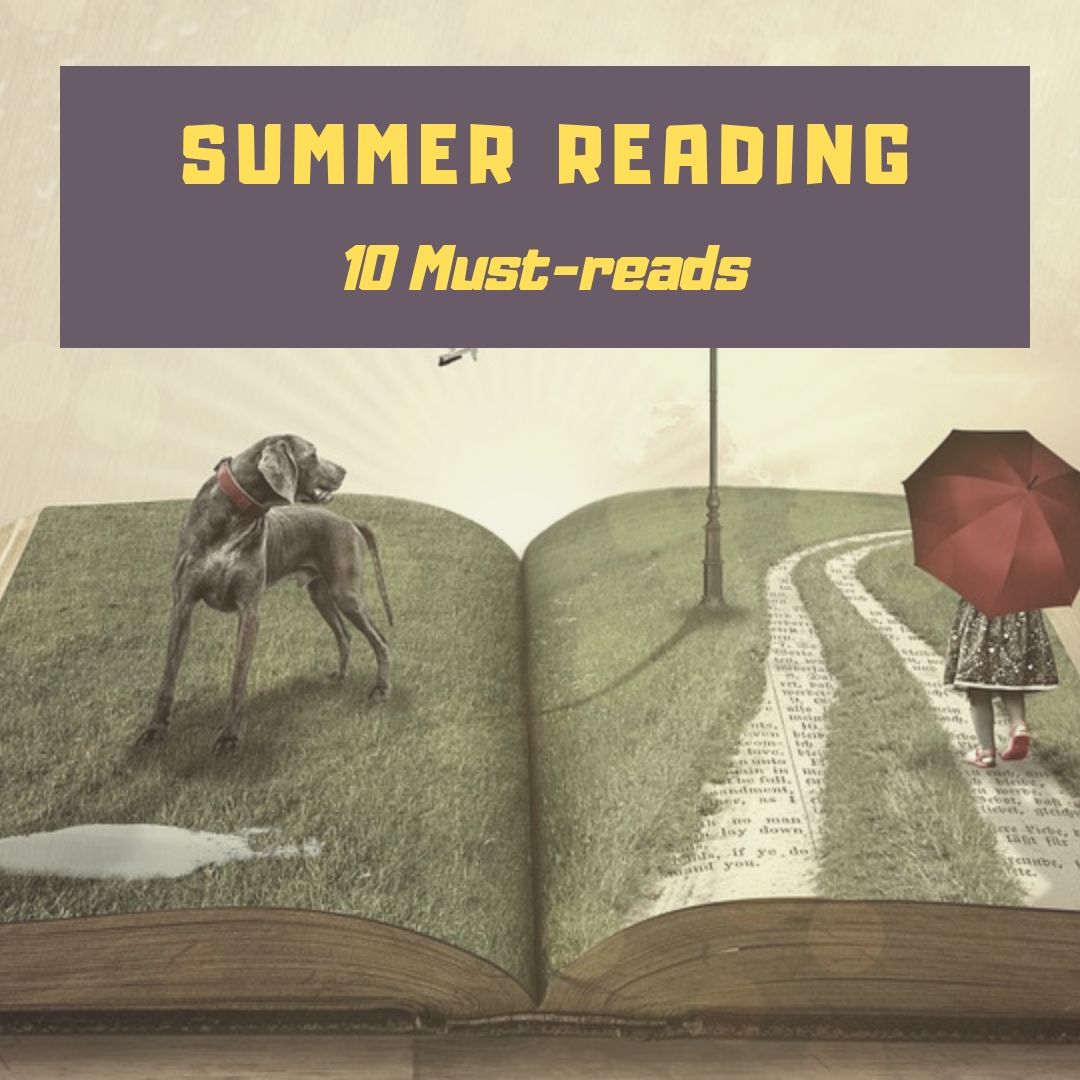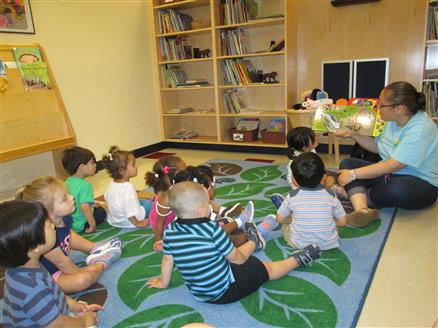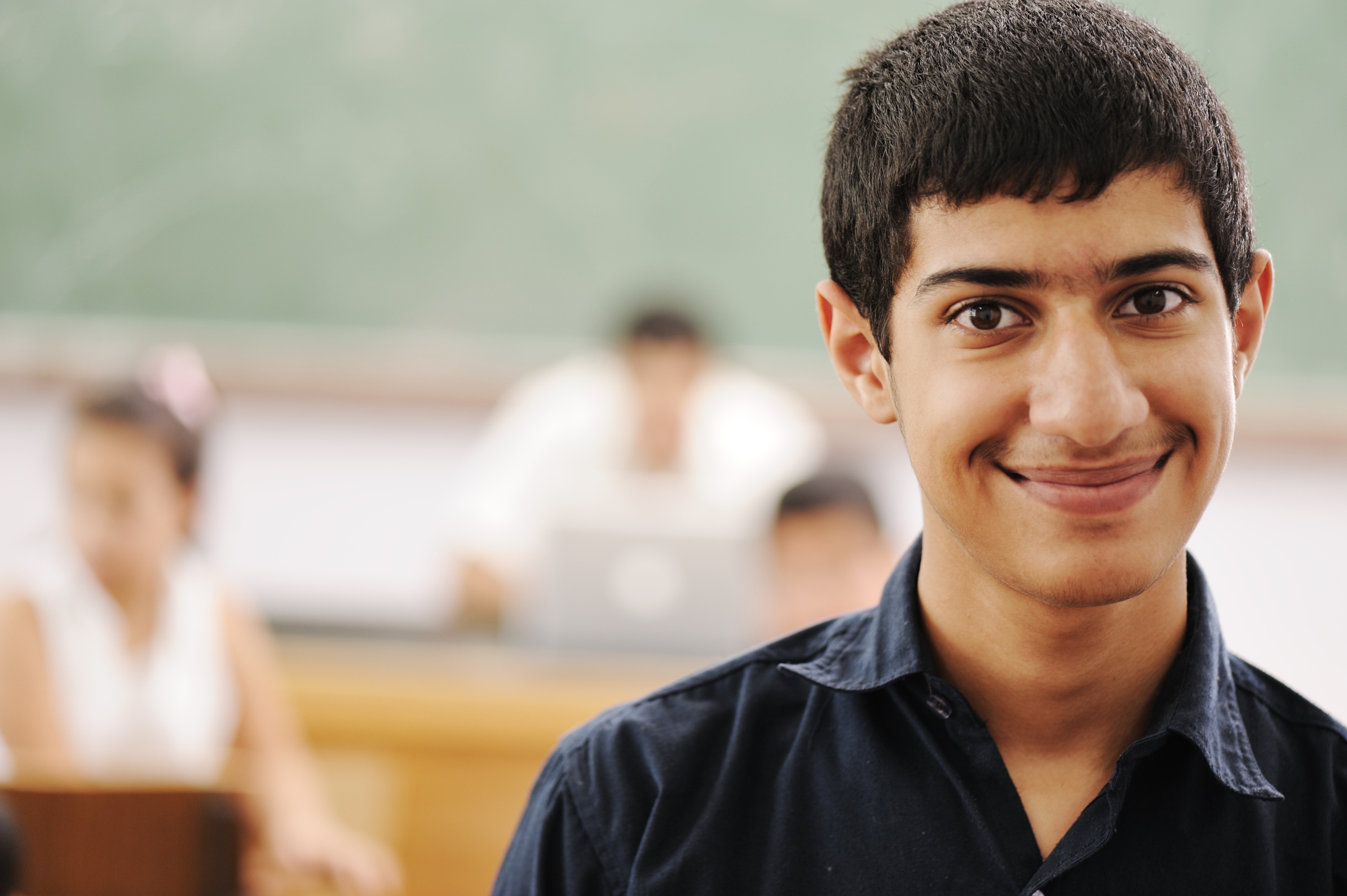Tag: pedagogy
13 Teaching Strategies to Shake up Your Remote Teaching
 As we struggle with adapting our classes to remote learning, I know lots of teachers who are realizing that their normal approach isn’t suited for remote teaching. They need to come up with a transformative tool that will reach students more comprehensively, more rigorously, more granularly online. Here are thirteen accepted pedagogical teaching strategies with proven records of success. Read through them then think how they might be applied to solve the problems you’re having with online teaching. For more information, click the link:
As we struggle with adapting our classes to remote learning, I know lots of teachers who are realizing that their normal approach isn’t suited for remote teaching. They need to come up with a transformative tool that will reach students more comprehensively, more rigorously, more granularly online. Here are thirteen accepted pedagogical teaching strategies with proven records of success. Read through them then think how they might be applied to solve the problems you’re having with online teaching. For more information, click the link:
Depth of Knowledge (DoK)
DoK is not a taxonomy (like Bloom’s). Rather, it itemizes ways students interact with knowledge.
Frayer Model
Frayer Model uses a graphical organizer that asks students to describe words by much more than a memorized definition.
Growth Mindset
In a Growth Mindset, people believe ability can be developed through dedication and hard work. The cerebral and physical traits they were born with are just the starting point. Students are responsible for setting the patterns and strategies that allow them to succeed, by evaluating what they can do at any given point and making a plan for learning everything else.
Habits of Mind
In the face of mounting evidence, education experts accepted a prescriptive fact: student success is not measured by milestones like ‘took a foreign language in fifth grade’ or ‘passed Algebra in high school’ but by how s/he thinks. Habits of Mind lists sixteen of these.
Orton-Gillingham
Orton-Gillingham is not a packaged curriculum, rather a prescriptive program designed for each individual student. The O-G teacher incorporates phonology and phonological awareness, sound-symbol association, syllable instruction, morphology, syntax and semantics into a personalized methodology
Project-based Learning (PBL)
John Dewey suggested the education focus be switched to students when he introduced “learning by doing”, today referred to as Project-based Learning (PBL).
Share this:
What is Constructivism and How Does it Fit Your Class?
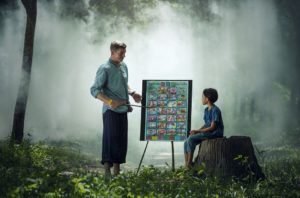 Constructivism is a student-centered philosophy that emphasizes hands-on learning and active participation in lessons. Constructivists believe that learning is an active process so the most effective way to learn is through discovery. With hands-on activities, learners actively create their own subjective representation of objective reality. Because new information is blended into prior knowledge, the result is – of course – subjective, heavily dependent upon the personal lens of each learner. That, in turn, is dependent upon their society, culture, past knowledge, personal experiences, and more.
Constructivism is a student-centered philosophy that emphasizes hands-on learning and active participation in lessons. Constructivists believe that learning is an active process so the most effective way to learn is through discovery. With hands-on activities, learners actively create their own subjective representation of objective reality. Because new information is blended into prior knowledge, the result is – of course – subjective, heavily dependent upon the personal lens of each learner. That, in turn, is dependent upon their society, culture, past knowledge, personal experiences, and more.
Learning is constructed, not acquired, and is based on the fullness of a person’s individual lifetime of learning. It is continuously tested as new ideas are added, either causing long-held beliefs to evolve or be replaced.
Constructivism is not a pedagogy or a theory. It is a mindset — a way of thinking used to guide learners.
Share this:
How Behaviorism Can Turn Your Classroom Around
 I first ran into Behaviorism in child psychology classes I took for my Early Childhood Education credential (ECE). It was developed by a renowned psychologist named John B. Watson and formed into the Theory of Behaviorism by another famous psychologist, B.F. Skinner. The technical definition they provide is:
I first ran into Behaviorism in child psychology classes I took for my Early Childhood Education credential (ECE). It was developed by a renowned psychologist named John B. Watson and formed into the Theory of Behaviorism by another famous psychologist, B.F. Skinner. The technical definition they provide is:
“…scientific and objective methods of investigation concerned with observable stimulus-response behaviors; all behaviors are learned through interaction with the environment.”
They used the infamous example of Pavlov’s Dogs. No surprise, with this gobbledegook definition that used dog training as the example, I laughed, rejected it, and then forgot it.
Fast forward a decade, to a time when I was studying for my teaching credential. One of my classes reviewed education pedagogies such as Purpose-driven Learning, the Socratic Method, Depth of Knowledge, Unschooling, and Behaviorism. Applied to education, Behaviorism focuses on:
“… conditioning student behavior with various types of reinforcements and consequences…”
I still cringe at words like “conditioning” and “consequences”, but in the fullness of the class, I came to understand that whether teachers know it or not, they use Behaviorism as an effective, reliable teaching tool. I’ll get back to that later but first, I want to deconstruct how a theory that started with training dogs is now a cornerstone in education pedagogy.
Share this:
10 Books You’ll Want to Read This Summer
 Summer is a great time to reset your personal pedagogy to an education-friendly mindset and catch up on what’s been changing in the ed world while you were teaching
Summer is a great time to reset your personal pedagogy to an education-friendly mindset and catch up on what’s been changing in the ed world while you were teaching eight ten hours a day. My Twitter friends, folks like @mrhowardedu and @Coachadamspe, gave me great suggestions on books to read that I want to share with you but first:
A comment on the selections: I did get more suggestions than I could possibly list so I focused on books that were positive and uplifting rather than dark and foreboding. Yes, there is a lot wrong with education around the world but I wanted a selection of books that would send me — and you — back to teaching in the fall with a can-do attitude for how to accomplish miracles with your next class of students.
Having said that, here’s a granular list of teacher-approved books to keep you busy this summer:
Digital Leadership: Changing Paradigms for Changing Times
by Eric C. Sheninger
Digital Leadership defines a strategic mindset and set of behaviors that leverage resources to create a meaningful, transparent, and engaging school culture. It takes into account recent changes such as connectivity, open-source technology, mobile devices, and personalization of learning to dramatically shift how schools have been run for over a century.
Disrupting Class: How Disruptive Innovation Will Change the Way the World Learns
by Clayton M. Christensen
Selected as one of Business Week’s Best Books on Innovation in 2008, Disrupting Class is filled with fascinating case studies, scientific findings, and insights into how managed innovation can unleash education. As important today as it was a decade ago, Disrupting Class will open your eyes to new possibilities and evolve your thinking. For more detail, read my review, Disrupting Class.
Share this:
Why Mastery Based Learning is a Good Option
 Last year, only 61 percent of students who took the ACT high school English achievement test were deemed college-ready. In math, it was even worse — only 41 percent. Without doubt, we teachers recognize this as a problem but what do we do about it? An option several school districts I converse with are trying is called “mastery-based learning” — MBL. When I read this article about it, I got pretty excited. This could be a solution, if not for all students, at least for those who don’t excel under traditional teaching.
Last year, only 61 percent of students who took the ACT high school English achievement test were deemed college-ready. In math, it was even worse — only 41 percent. Without doubt, we teachers recognize this as a problem but what do we do about it? An option several school districts I converse with are trying is called “mastery-based learning” — MBL. When I read this article about it, I got pretty excited. This could be a solution, if not for all students, at least for those who don’t excel under traditional teaching.
What is MBL
Also known as “competency-based learning” or “proficiency-based learning”, mastery-based learning is described by The Glossary of Education Reform as:
“a system “of instruction, assessment, grading, and academic reporting … based on students demonstrating that they have learned the knowledge and skills they are expected to learn as they progress through their education.”
Learning is personalized, based on school standards. Students who don’t understand a topic and don’t do well on the summative assessment for that subject, aren’t automatically moved on because time allotted for that topic ran out. Instead, they are given additional support and then retested until they have the skills to move on to the next stage.
Share this:
Purpose Driven Learning: Myths, Problems, and Education Applications
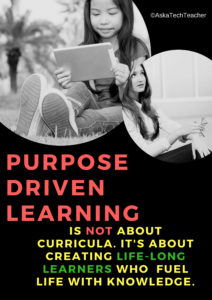 Purpose Driven Learning (or PDL) is a concept coined by Michael Matera and Adam Moreno to summarize the philosophy that each learner’s inner strengths can be unlocked by focusing with purpose and drive. By following the guidelines for Purpose Driven Learning, teachers avoid the biggest pitfall in many lesson plans — that they are theoretic without meaning in the real world. With PDL, resources are relevant, lessons are personalized, and real-life connections are placed under a bright light. In the end, learning is changed from pedantic to powerful and students learn to reliably connect academic studies to the world outside the schoolhouse.
Purpose Driven Learning (or PDL) is a concept coined by Michael Matera and Adam Moreno to summarize the philosophy that each learner’s inner strengths can be unlocked by focusing with purpose and drive. By following the guidelines for Purpose Driven Learning, teachers avoid the biggest pitfall in many lesson plans — that they are theoretic without meaning in the real world. With PDL, resources are relevant, lessons are personalized, and real-life connections are placed under a bright light. In the end, learning is changed from pedantic to powerful and students learn to reliably connect academic studies to the world outside the schoolhouse.
The Goal of PDL
In a phrase:
…the goal of Purpose Driven Learning is NOT about a curriculum that lasts a year. It’s about creating life-long learners who fuel their future passionately with knowledge.
This applies to both 1) education pursued with the goal of college or career, and 2) the critical preparation of students to succeed in life. Purpose Driven Learning, faithfully delivered with buy-in from students, will result in students willingly participating in even the boring lesson pieces (like worksheets or podcasts) as well as exciting applications like simulations and student-devised projects.
Problems implementing Purpose Driven Learning
Engaging PDL in your classroom is seen by some as teaching students what they want to learn at the expense of what they need to learn but this isn’t true. Done right, students come to understand that real knowledge relies on a solid foundation of data upon which they build their personal interests. For example, students who want to join America’s proposed Space Force must first be grounded in the basics of science and math.
Educators who wish to use PDL often run into three roadblocks:
School Standards. Because state and national standards are often devised to serve the majority of students, they may not well-serve your students. But they do provide a necessary foundation without which the goals of your particular group can’t be met. That means that standards are taught first and additional learning is scaffolded afterward. Standards are in fact the foundation that underpins your students’ ability to achieve their PDL goals.
Share this:
Differentiating with Personalized Learning
Personalized learning is the latest buzzword in an education environment bursting with new ideas but this one is impressive. In a sentence, personalized learning:
“tailors instruction, expression of learning, and assessment to each student’s unique needs and preferences.” — ISTE
If you think it sounds like differentiated instruction, it does with this caveat: Personalized learning is student-directed, student-paced, and designed for each learner.
Why switch to personalized learning?
There are many reasons to take a deep dive into personalized learning. Some schools realize students aren’t learning to their full potential. They see this not just in test results but in student response to the grade-level curricula. They feel it is unrelated to what happens to them outside of school. We as teachers know that math and science can easily be taught using real-life experiences in lieu of a textbook. The problem in the past has been convincing our learning partners of that truth. Now, anecdotal evidence shows that well-delivered personalized learning encourages excitement about learning, improves test scores, and leaves students wanting to learn even complicated math and science topics.
Share this:
The Important Morning Meeting
 One of the strategies I grew to appreciate in my several decades of teaching was starting my class with a warm-up. A tangible transition between the previous class (or recess) and mine seemed to orient students to my topic and make the entire class go more smoothly. For me, because I taught what is called specials or pull-outs (I taught technology), I did this at the beginning of a class period. When you do this at the beginning of the day, it’s called not a warm-up but a morning meeting.
One of the strategies I grew to appreciate in my several decades of teaching was starting my class with a warm-up. A tangible transition between the previous class (or recess) and mine seemed to orient students to my topic and make the entire class go more smoothly. For me, because I taught what is called specials or pull-outs (I taught technology), I did this at the beginning of a class period. When you do this at the beginning of the day, it’s called not a warm-up but a morning meeting.
What is a Morning Meeting
Morning meetings are a time when students and teacher gather together, usually in a circle, for an organized start-of-day activity. They can be as quick as fifteen minutes or as long as thirty. You determine this based on what students need to start their day as lifelong learners. Some days are quick; others, not so much. That’s OK. In fact, it’s good to be flexible with the schedule and responsive to student needs. They learn faster when you’re listening to them and come to believe they are worthy. As such, they begin to believe in themselves.
Goals of a Morning Meeting
The broad purpose of a morning meeting is to transition students between home and school, to greet them as you would a guest in your house. It’s an informal way to re-acquaint everyone with each other and with the classroom ecosystem. Think of it on par with a family dinner, where parents and children come together in a relaxed environment to do something everyone enjoys. You start by welcoming students, reviewing the day’s activities, discussing changes in the classroom, meeting new students, celebrating the accomplishments of classmates, and anything else that benefits from a whole-group meeting.
Share this:
Positive focus; Positive behaviors
There’s a lot of chatter about PBIS (Positive Behavioral Interventions and Supports) on educator forums I participate in. I don’t have direct experience with it so I jumped at the chance to share Middle School teacher Karessa Parish’s experiences. In this article, she explains what PBIS is, lessons learned rolling it out, and a tool called Hero that helped make it happen in her school:
 Studies show that students need a ratio of about five positive interactions to every negative. Up until a year and a half ago, our campus had this ratio all wrong. It seemed like we were giving five negatives for every positive. Our teachers were spending more time on a small percentage of the students who were having trouble or who were making trouble. We were spending 80 percent of our time focusing on 20 percent of our students, who were the ones with behavior issues. But that means 80 percent of our students were excellent and weren’t getting the recognition that they deserve. The result was that the vast majority of our students — students who were doing the right thing — were getting little positive attention from our faculty. We decided to refocus our attention to be intentional in recognizing positive everyday occurrences that had been overlooked for too long and we picked Hero to help us do this.
Studies show that students need a ratio of about five positive interactions to every negative. Up until a year and a half ago, our campus had this ratio all wrong. It seemed like we were giving five negatives for every positive. Our teachers were spending more time on a small percentage of the students who were having trouble or who were making trouble. We were spending 80 percent of our time focusing on 20 percent of our students, who were the ones with behavior issues. But that means 80 percent of our students were excellent and weren’t getting the recognition that they deserve. The result was that the vast majority of our students — students who were doing the right thing — were getting little positive attention from our faculty. We decided to refocus our attention to be intentional in recognizing positive everyday occurrences that had been overlooked for too long and we picked Hero to help us do this.
We wanted to flip the culture at our school. We had two objectives when we created our Positive Behavioral Interventions and Supports (PBIS) program and started using Hero:
- Motivate the students who weren’t following expectations
- Celebrate the kids who were doing what they were supposed to be doing
Hero helps teachers and administrators monitor all forms of student behavior, both good and bad. Using any web browser or an Android or iOS device, teachers and administrators can capture student behavior where and when it happens, keep accurate attendance records, and assign warnings and consequences (or rewards for positive behavior) automatically. We have customized the software with specific behaviors, incentives, and interventions. Our students can track how many points they have accumulated through the Hero app, and they can redeem their points in the school store. We have a variety of incentives ranging from mystery brown bags with three or four trinkets in them to earbuds and t-shirts. We also host parties like student vs. teacher basketball games, Powder Puff games and time on the athletic field with snow cones. These parties are hosted every six weeks that students can use their Hero points to attend.
Share this:
How to Build Lifelong Learners
If there is a trait above all others that I want to imbue into my students, it is curiosity. Let that include a passion to understand, connect the dots, and answer questions like, “Why?” The first step toward reaching that goal would be opening their minds to fascinating bits and pieces of knowledge, be they about computer games or nature. That Wow feeling is addictive, as is the high of connecting the dots, solving a puzzle, and unraveling the mysteries of life itself.
 I respect the job done by education programs around the world, but six to eight hours a day five days a week can only go so far. Teachers get tangled in a web of standards, mission statements, and assessments, and spend too much time on what their institution considers essential. While this is a good starting point, it has to often become an endpoint, something it was never intended to be. John Dewey, one of the most influential voices in American education in the early 1900’s, once said:
I respect the job done by education programs around the world, but six to eight hours a day five days a week can only go so far. Teachers get tangled in a web of standards, mission statements, and assessments, and spend too much time on what their institution considers essential. While this is a good starting point, it has to often become an endpoint, something it was never intended to be. John Dewey, one of the most influential voices in American education in the early 1900’s, once said:
Education is not preparation for life. Education is life.
What does that mean? Decades earlier than Dewey spoke those words, John Adams defined them:
“You will ever remember that all the End of study is to make you a good Man and a useful Citizen.”
Renowned linguist, philosopher, historian, and scientist, Noam Chomsky says it this way:
“Education is really aimed at helping students get to the point where they can learn on their own. . . ”
Rephrased, this defines education as not about academic success, learning the 3Rs or graduating top in the class. The goal is bigger, more far-reaching, and more difficult to achieve. It’s about building lifelong learners.



